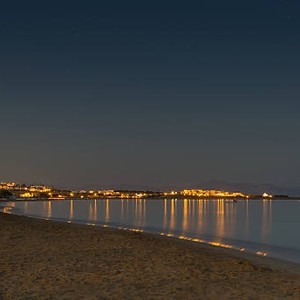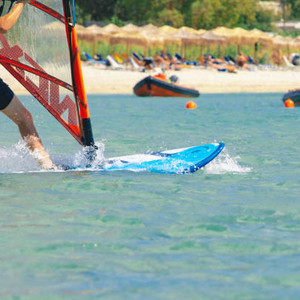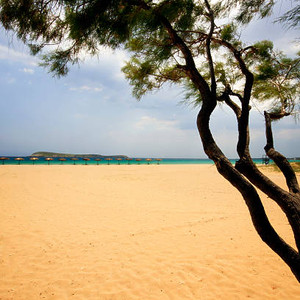Location
The 700-meter-long sandy “blue flag” beach of Chryssi Akti (Golden Beach) is truly one of the most remarkable beaches in the Mediterranean. Formerly home to the windsurfing world cup, it now offers water-sports for all ages and levels of expertise: windsurfing, sailing, sea kayaking, water tubes and bananas, water skiing and within a short distance scuba diving can also be enjoyed as well as yoga, massages, etc. A lifeguard tower and rescue speedboats also exist. Beach-volley and backgammon or dipping in the crystal-clear blue waters, relaxing on a sun bed under the shade of a palm tree-leaf umbrella, sipping a refreshing drink while listening to pop music at one of the well-organized beach-bars or chilling in one of many isolated spots the huge beach has to offer is what a great vacation is all about! Within walking distance are various eateries, mini-markets and when the sun sets, bars with a wide selection of drinks. Getting to and from this fantastic site is easy. Rent a car or motorbike or use the local bus. The main town and port of Paroikia is 25 km. away, the airport 20 km.
From the port of Punta, 16 km from Golden Beach, a brief boat-trip away is Antiparos Island (Tom Hanks owns a home there as well as other celebrities), where a beautiful cave exists worth visiting. If bar-hopping is what you enjoy, 12 km. away is the quaint town and port of Naoussa that hosts non-stop clubbing and luxe shopping. Paros is truly a magical island offering everything anyone can ask for!
A brief coastal walk to the south (1.5 km.) will get you to the small settlement and port of Drios. At the port, now home to small fishing boats but also yachts in summer, you can see the small church of St. Nicholas, patron saint of the sea. Ancient dockyard ruins that exist all around Paros are particularly visible here where the ancient residents of Drios kept their ships during the winter to repair or protect them.
Towards the north of Golden Beach (3,5 km.) is the small resort of Logaras where on the low hill near the settlement is a church, St. George of the Sea, dating from the 13 th century. The pirates who preyed in the area kept their treasures within a secret gallery inside its walls. They placed their diamonds and precious stones in the eyes of the saints depicted in the frescoes (unfortunately currently not well preserved) as they knew the locals would not dare touch them.
A mere 500 meters to the north from Logaras is the scenic coastal settlement and port of Piso Livadi, the departure point of small excursion boats to Naxos (which is clearly visible) and other islands. At the strait between Paros and Naxos is a shipwreck, the mast visible, that can be enjoyed while snorkelling or diving at the site.
To the west of Piso Livadi (2 klm) is the picturesque inland village of Marpissa. The architecture and the plan of the settlement are beautiful and its well preserved white-washed buildings date from the 16 th and 17 th century. The village boasts many interesting churches with icons and precious religious artifacts although the most fragile of them are now on display at the local Byzantine Museum. Worth visiting are also the Folk Collection and the Sculpture Museum. The main square is a museum in itself as it is surrounded by outdoor paintings made by a local folk artist. A lovely 20-minute walk from the old wind mills on the outskirts of Marpissa towards the east to Kefalos hill will offer you a panoramic view of the island. Situated on the hill is the 16 th century monastery of St. Anthony. It has a lot of architectural parts of ancient temples and buildings clearly visible. The pulpit in the church is based on the capital of an ancient column turned upside down. Traces of a Venetian Castle (Beautiful Woman Castle) in honor of the wife of its lord Sommarippa (thus the name of the village) are also visible. The lord heroically resisted the attack of the famous pirate Barbarossa who finally destroyed it to the ground. On the way to the traditional village of Prodromos, 1,5 klm. west of Marpissa, you can visit the Monastery of St. Panteleimonas, built in 1655.
Prodromos is an inland village home to Archilochos, the famous lyric poet of Archaic times. What makes Prodromos unique is the Byzantine footpath connecting it with the village of Lefkes. This footpath was constructed with big marble slabs that are still in good condition more than 1000 years ago. This route of exceptional beauty is about 5 klm. long and well worth the effort!
Arriving at the mountainous traditional village of Lefkes, framed by wind mills, it is clear that it was one of the richer villages of the island. Built in the 15 th century, it was the center of commerce and the former capital as well. The marble pedestrian street leading to the square is one of the many interesting features as it divides into a network of narrow streets with whitewashed benches at their sides. There are a multitude of churches hosting important old icons like St. Theodosia with icons and frescoes dating from the 17 th century. It’s worth visiting the traditional weaving and pottery workshops as well as the two Folk Museums. Next to the village at the site of Apati, you will be impressed by the huge olive trees that were planted in antiquity. At a distance of 3,5 klm. northeast to the village is the holy monastery of St. John dating from the 17 th century and if you get to the top of the “All Saints” hill, you will enjoy a panoramic view of the entire island.
All kinds of businesses may be found in the area; supermarkets, a hair and nail salon, many eateries and more.
_edited.png)















